Kit Chapman explores the chemical cost of the most dangerous industry in the world
Alang, a small town in the western Indian state of Gujarat, is where ships go to die. You’ll find them along the shoreline, locked deep into the mud, their frames slowly rusting as they are stripped of all value. Container ships, freighters, cruise liners and even aircraft carriers all find their home here, many flying fake flags to bypass regulations. The largest of these behemoths often strike the bottom almost 1000m from shore and need to be winched from the brown swirl of the Gulf of Khambhat during high tide, slowly edging toward the beach over days or weeks. Once free of the ocean, these giants join the other carcasses to be scoured clean by Alang’s 15,000 workers, few wearing protective equipment. These represent a fraction of the 500,000 people in India alone whose livelihoods depend on the work.
The hulks are spread out for miles amid cranes and debris, the shipyard fires blazing and cutting tools grinding around the clock. The work is systematic; nothing is spared and everything sold, either by the yards or the mile-long row of scrap merchants outside the gates. Items ranging from cutlery and lightbulbs to watertight doors, washing machines and even lifeboats are for sale at a fraction of their original price.
Around 600 large ocean-going vessels end up on one of three beaches in South Asia every year
Alang, and other harbours like it in Gadani, Pakistan, and Chittagong, Bangladesh, is home to shipbreakers. Although such recycling should be a green activity, the International Labour Office considers it one of the most dangerous jobs in the world, fraught with chemical peril – and one whose pollutants are damaging both the local environment and the communities living nearby.
A human cost
The scale of the operation is massive, explains Ingvild Jenssen, executive director of Shipbreaking Platform, a non-governmental organisation that polices ship recycling. ‘Every year, around 800 large ocean-going vessels get broken down. About 75% of them end up in one of the three beaches in South Asia,’ Jenssen explains. In terms of tonnage being scrapped, however, the three countries deal with 90% of the world total.
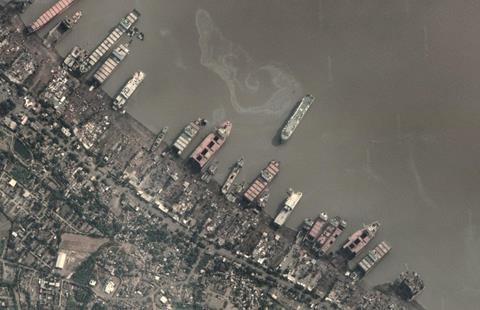
These ships bring a host of dangers. Workers are routinely exposed to carcinogens including polychlorinated biphenyls (PCBs), polyvinyl chloride, polyaromatic hydrocarbons (PAHs), tributyltin compounds, mercury, lead, isocyanates and sulfuric acid. Asbestos is another major risk: on average, each ship contains seven tonnes of the material – all of which ends up being removed by hand. In 2015, a study from Taiwan looked at population data from 4427 shipbreaking workers and found that, from 1985 to 2008, 940 had died of cancer, with 436 more developing various forms of the disease; those with the highest exposure to asbestos were more likely than the general population to develop cancer overall, particularly of the oesophagus, liver, trachea and lungs.
‘When you’re torch-cutting a vessel, the anti-fouling paints, which contain large amounts of heavy metals, will also heat up and release toxic fumes,’ Jenssen adds. ‘You’ve got PCBs, ozone-depleting substances, and many residue oils that may cause gases to explode. You’ll have people torch-cutting in a vessel that catches fire, and workers being trapped in areas that they can’t escape.’
These dangers don’t just affect the dockworkers themselves, says Soumya Haldar, senior principal scientist at the Central Salt & Marine Chemicals Research Institute in Bhavnagar, India, who is responsible for independent environmental assessments of Alang’s ship recycling. Before he started work in 2001, there had been no baseline measurements to determine the industry’s impact. ‘The main pollutants are residual oil, oxyacetylene gas from cutting, as well as iron and other metals,’ he says. As the crafts are beached – flooding the hulls at high tide – these substances are washed into the surrounding area. ‘Another important issue is ballast water, which the ships take on from other countries,’ Haldar explains. Although this is released before the ship is broken up, there may be sediment containing exotic species that could affect the local ecology. His studies of ballast sediments have yet to find any invasive species.
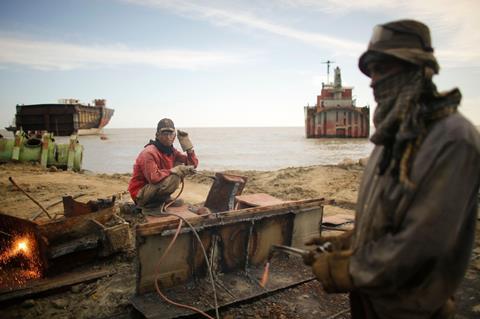
The ships themselves are only part of the problem. ‘The pollution is not only coming from the recycling facilities,’ says Jenssen. ‘It’s also from the steel mills that are rewelding the steel afterwards, without proper filters to reduce emissions. The downstream waste management infrastructure is also sorely lacking in these areas – even the asbestos will be resold.’ Bangladesh, Jenssen adds, has no capacity in the entire country to manage the hazardous materials its shipyards work with on a daily basis.
This combination of activities can have a severe impact on air quality. In 2015, Therese Nøst, a postdoc at the Norwegian Institute for Air Research at the time, now a researcher at the Arctic University of Norway, worked with Bangladeshi colleagues to conduct an atmospheric chemistry assessment at Chittagong, an area with a population of around 8.7 million people in the vicinity of its shipyards. ‘There hadn’t been any studies at that point on contaminants in the air,’ Nøst says. ‘We basically set up samplers made of a material similar to polyurethane mattresses between two “salad bowls”, and we hung them up around Chittagong. We [used] 25 data points for the area, looking for compounds we hypothesised would come from shipbreaking, as well as more urban activities so we could compare patterns between locations and performed chemical analyses of PAHs, PCBs, brominated flame retardants and short-chain chlorinated paraffins.’
The results were clear: levels of PCBs, PAHs and more were highest around shipbreaking sites, and were higher than the carcinogenic risk limit in 18 of the 25 measurement sites. ‘Based on the concentrations, we calculated the risk for detriment to human health at most of these sites. These were scary numbers to see. There are far worse threats to human health on an everyday basis due to accidents in these activities, but these risks add to it. And all the others [who live nearby] have to inhale the air.’
Given the dangers posed by shipbreaking, then, there’s an obvious question: is anyone doing anything about it?
Flags of convenience
Although ports on the Indian subcontinent date from prehistory, modern shipbreaking first arrived during the 1980s, thanks to a combination of lax regulation and the huge tidal variations that make the area an ideal location for beaching vessels. Today, it offers the highest profits for anyone looking to dispose of a ship. Part of this is down to low overheads and cheap labour – workers are often paid as little as $1 a day, while in Chittagong an estimated 13% are children. But demand for raw materials in developing countries also plays a role, Jenssen says. ‘The vessels are being dismantled so that the steel can be reused. Overall, it’s a good activity [for countries like India, Bangladesh and Pakistan], because you’re recycling and reusing steel … right now, selling a vessel to a beaching facility would get maybe $500 (£371) per tonne. If you sold it to Turkish facility you would get maybe $250 per tonne of steel. And if you sold it to a European facility you would get maybe $150.’
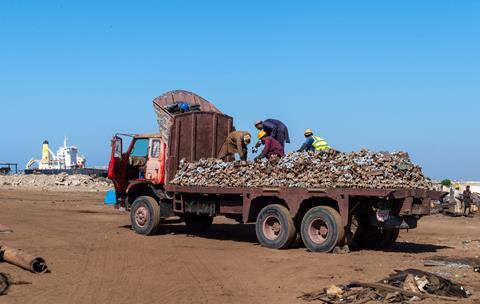
Usually, merchant lines do not dispose of ships directly. Instead, they will sell the vessel for cash to specialist scrap dealers with ties to the beaches. International regulation of this trade is thwarted by numerous loopholes. The United Nations Convention on the Law of the Sea requires all ships to fly the flag of a nation, and thus be subject to that country’s law. But around three-quarters of merchant ships fly the flags of countries with lower taxes or looser safety standards (typically Panama or Liberia). For a ship’s final voyage to a breaker yard, the flag often changes to a country known for poor maritime standards and environmental protections – such as St Kitts and Nevis, Comoros or Palau – while masking the true owner of the vessel. ‘That makes it extremely difficult to hold entities accountable,’ Jenssen says. ‘There’s also the Basel Convention, which is on the trans-boundary movements of hazardous wastes, such as end-of-life vessels.’ The problem is that a vessel only counts as hazardous waste once the company announces its intention to dispose of it. ‘It’s very easy for ship owners to simply claim that they’re on an operational voyage, sail all the way to India, Bangladesh and Pakistan, and only then declare that the vessel is actually heading for scrap. It makes it impossible to enforce that piece of law. There are many ways for the shipping industry to circumvent existing legislation.’
Crackdowns on the disposal of ships are happening, particularly in Europe. In 2018, the Dutch company Seatrade was found guilty of illegally disposing of ships in India, facing a fine of €750,000 (£629,000), with two directors barred from holding posts in the shipping industry for a year. Similarly, in 2017 a case in Norway saw a company director receive a six-month prison sentence. Yet these are the exceptions, rather than the rule. ‘In 2009, the Bangladesh Supreme Court ordered the closure of the entire sector because they weren’t complying with any of the national environmental requirements, or any of the national labour requirements,’ says Jenssen. ‘The facilities closed for about three to six months, depending on the job. But they all opened again, with environmental clearance certificates, saying that they complied with 20 of the 64 requirements and had another year or two years to comply with the rest.’ Business resumed with little change.
Ship recycling itself is governed by the 2009 Hong Kong Convention, which covers disposing of ships without posing a risk to human life or the environment, as well as setting out standards for the recycling of asbestos, hydrocarbons, ozone-depleting substances and heavy metals. India is one of the countries that has signed up to the convention, Haldar says, and the results of that action are being seen at Alang. ‘Under the treaty, ship recycling cannot be done in the water itself – they grab the part and move it to a separate area of the yard, so no contamination can occur.’ Simply put, by taking the hulk off the beach and into drydock, there’s nowhere for any chemicals to go. ‘As a result, metal pollution has reduced dramatically.’ For example, in 2004, measurements taken at Alang showed high concentrations of iron, zinc and manganese in local seawater. Following the installation of dedicated treatment, storage and disposal facilities – including landfills, effluent treatment plants and high-temperature incinerators – as well as enforcement of the convention, concentrations are now falling, Haldar says. Even so, the convention is only a decade old and full uptake has been slow, with only around half of the plants using the new facilities.
That means more can still be done.
Turning the tide
‘Good ship recycling,’ Jenssen says, ‘is done in a place where you can contain pollutants where you dispose of them safely also downstream, where you recycle all our parts that can be recycled, and workers’ health is properly monitored; where you have safe working conditions. It’s not hocus-pocus technology: vessels regularly need to enter dry docks for maintenance. If you recycled vessels in a dry dock as well, you could contain the pollutants … there is a huge potential to improve and make ship recycling more cost effective and safe at the same time. For example, by using mechanical cutting.’
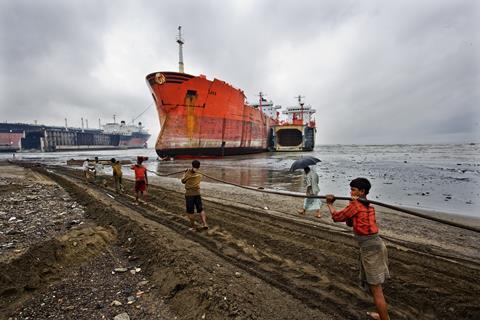
Decontamination can also take place before the ship starts its journey – actively removing PAHs and other carcinogens before the ships arrive at the breaker’s yards will effectively curb environmental danger, but with an estimated cost of $25–50 per tonne, would result in substantial overheads. Another option, advocated by the Indian government in 2001, is to place more emphasis on responsible shipbuilding: by ensuring new vessels contain few hazardous materials, the problem is eliminated before it has begun. This could be encouraged by incentivising insurers to offer lower premiums for green vessels, although it still wouldn’t address the existing 90,000 ships that make up the global merchant fleet.
The good news, Haldar says, is that if the changes are made, chemical analysis indicates the damage to the environment is reversible. Throughout the pandemic, shipbreaking activities at Alang largely ceased, giving his team an ideal window to investigate how the Gulf of Khambhat could recover if the industry moved to sustainable practices. ‘From February to May 2020, there were no activities at Alang,’ Haldar says. ‘We collected all the data from the air and water, and compared that data with 2019 and 2018 data. The levels of heavy metals and other things came down to [almost] zero.’
After just three months of pausing the work, Haldar’s team found PM10 levels – particulate matter smaller than 10μm that can be inhaled – were reduced by up to 85% compared with previous measurements, while NO2 and O3 fell to within safe limits. Similarly, coastal waters continued to show lower concentrations of heavy metals. ‘This means that environment itself has the capacity, if it is getting polluted, for natural remediation if we don’t have further anthropogenic impact,’ Haldar says. ‘So, if there is any accidental pollution in the future, we can take the proper measures. The environment has a capacity to rejuvenate itself.’
On land, conditions are still poor. In 2019, the Tata Institute of Sciences in Mumbai found there were still problems with basic sanitation, including more than half of workers not having access to a toilet, 43% not having access to safe drinking water, and only 30% of workers having access to safety equipment. Progress may be slow, but labour laws are in place to force change and, Haldar insists, local chemists will continue to hold the shipbreaking companies to account.
Even so, the battle over to reduce the impacts of ship recycling in South Asia is only beginning. ‘Just before this interview, I looked at Google Earth and zoomed onto the beaches,’ Nøst says. ‘You can still see the ships. There are some improvements, they aren’t as stacked as they were a few years back. But it’s still an issue and, for sure, the environment around there means you’ll have toxic tides for coming years as well.’
Janssen agrees. ‘Last year, the Bangladesh government announced that they were downgrading shipbreaking from a red industry to an orange industry, meaning that they won’t need to give out any environmental impact assessments anymore. This is going to be a long-term problem.’
Kit Chapman is a science writer based in Southampton, UK. His latest book, Racing Green, is published by Bloomsbury in March 2022
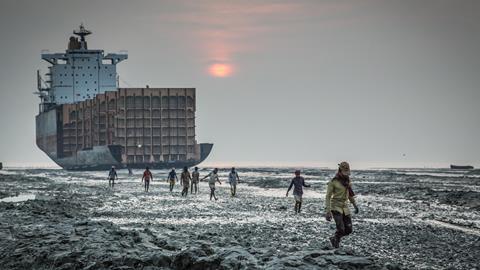
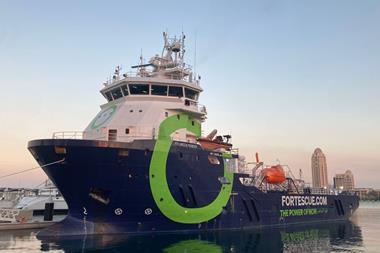




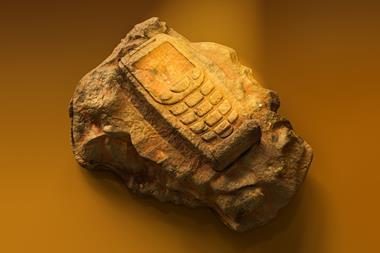






No comments yet